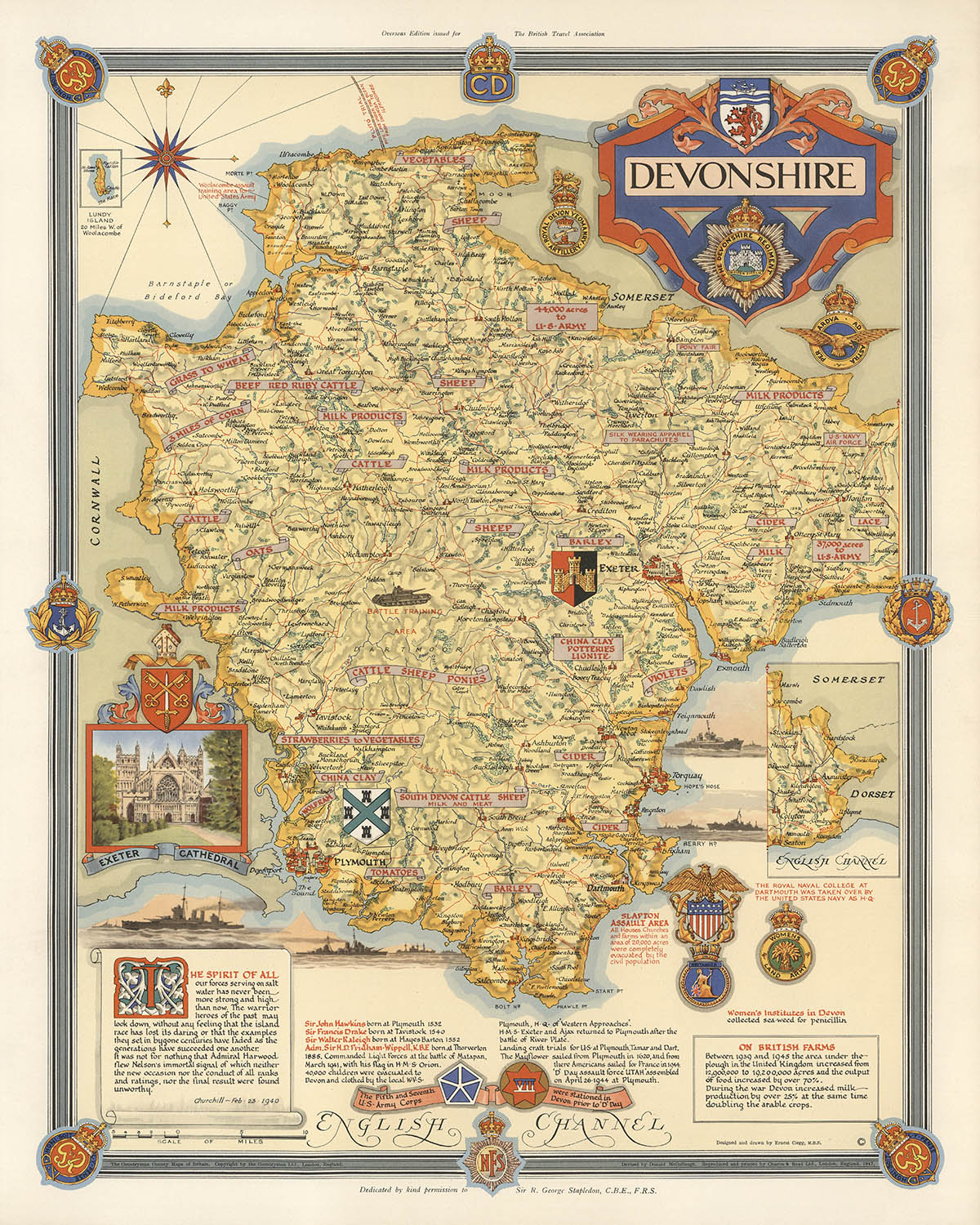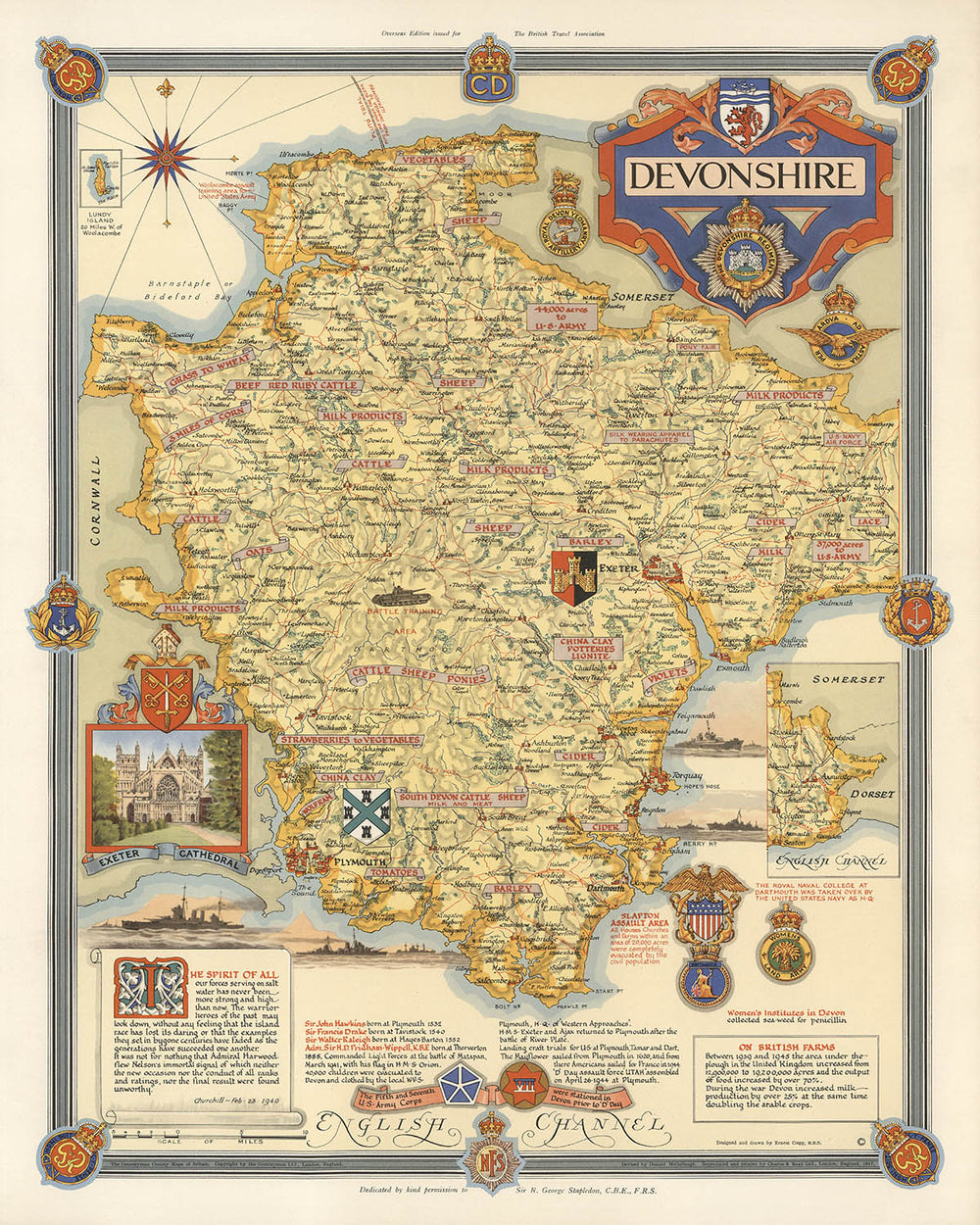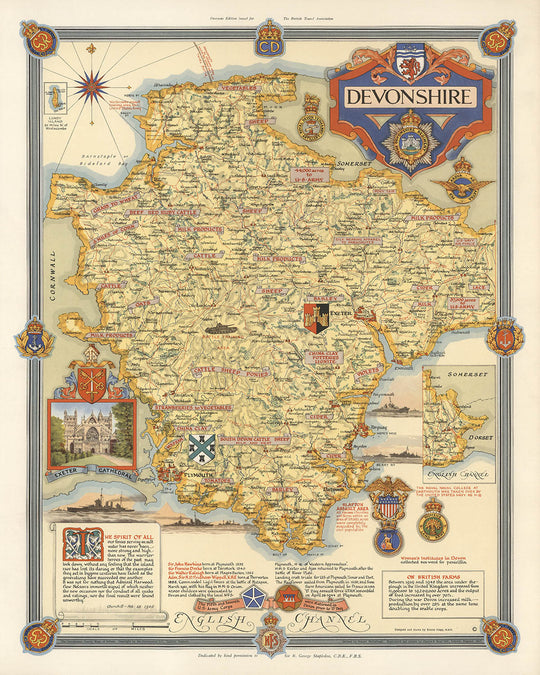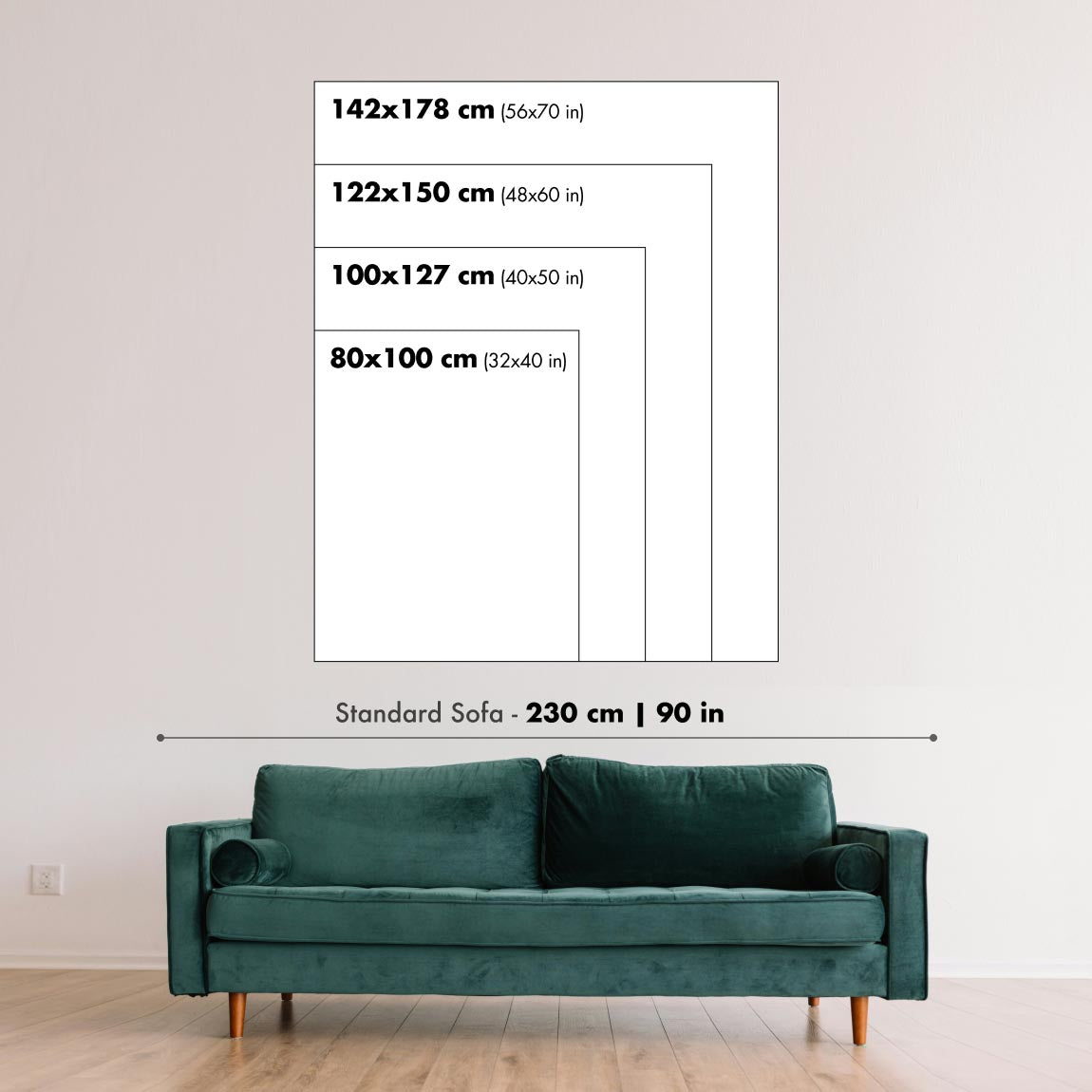- Handmade locally. No import duty or tax
- FREE Delivery by Christmas
- Love it or your money back (90 days)
- Questions? WhatsApp me any time
Own a piece of history
5,000+ 5 star reviews


Introducing the "Pictorial Map of Devonshire," a captivating creation by the renowned cartographer Ernest Clegg, M.B.F., published in 1947. This exquisite map, part of the Countryman County Maps of Britain series, is a celebration of Devonshire's rich heritage and its significant role during World War II. Designed with intricate detail and artistic flair, the map features colorful vignettes of historical places, making it not only a geographical guide but also a visual journey through time.
Ernest Clegg's masterful craftsmanship is evident in every aspect of this map. Known for his detailed and artistic cartographic works, Clegg's dedication to capturing the essence of British heritage shines through. The map is adorned with city coats of arms, decorative elements, and annotations that highlight the natural attributes and historical sites of Devonshire. Each illustration and note is meticulously crafted, reflecting Clegg's passion for history and cartography.
The map offers a comprehensive view of Devonshire, showcasing its cities, towns, and points of interest with remarkable precision. From the bustling city of Plymouth to the historic town of Exeter, every settlement is marked with care. The map also highlights significant landmarks such as the Exeter Cathedral, the Royal Naval College at Dartmouth, and the coastal defenses that played a crucial role during WWII. The inclusion of these historical sites provides a deeper understanding of Devonshire's past and its contributions to the war effort.
Natural beauty is another prominent theme in this map. The lush landscapes of Dartmoor and Exmoor National Parks are depicted with great detail, emphasizing the region's diverse topography. Rivers, mountains, and coastal areas are intricately illustrated, offering a glimpse into the natural wonders of Devonshire. The map also notes the agricultural richness of the region, highlighting British farms and their contributions to the local economy.
The historical significance of this map extends beyond its geographical features. Created just after the conclusion of WWII, it serves as a tribute to the allied activities and bases in Devon. Annotations about the U.S. and allied forces, including the U.S. 29th, 4th, 1st Infantry Divisions, and the 82nd and 101st Airborne Divisions, underscore Devonshire's strategic importance during the war. This map is not just a navigational tool but a historical document that commemorates the bravery and resilience of those who served.
Cities and towns on this map
- Plymouth
- Exeter
- Torquay
- Paignton
- Barnstaple
- Tiverton
- Newton Abbot
- Bideford
- Teignmouth
- Exmouth
- Brixham
- Honiton
- Okehampton
- Tavistock
- Seaton
- Sidmouth
- Ilfracombe
- Crediton
- Dartmouth
- Kingsbridge
- Axminster
- Totnes
- Ivybridge
- Lynton
- Lynmouth
Notable Features & Landmarks
- Exeter Cathedral (illustrated vignette)
- Dartmoor National Park
- Exmoor National Park
- Royal Naval College at Dartmouth
- RAF Harrowbeer (WWII airfield)
- U.S. Army bases (marked with symbols)
- Women's Institute in Devon (noted for its war effort support)
- British farms and agricultural products (noted on the map)
- Coastal defenses and fortifications
- Historical notes on Sir Francis Drake
- Historical notes on Sir Walter Raleigh
- Historical notes on the Spanish Armada
- Historical notes on the Battle of Britain
- Historical notes on the Normandy Invasion
- Historical notes on the U.S. 29th Infantry Division
- Historical notes on the U.S. 4th Infantry Division
- Historical notes on the U.S. 1st Infantry Division
- Historical notes on the U.S. 82nd Airborne Division
- Historical notes on the U.S. 101st Airborne Division
- Vignettes of Devonshire's natural landscapes
Historical and design context
- The map includes colorful vignettes of historical places.
- Created just after the conclusion of WWII, it celebrates the natural attributes and historical sites of Devonshire.
- Contains historical notes about WWII and U.S. and allied activities and bases in Devon.
- Shows cities, points of interest, and city coats of arms in very high detail.
- Dedicated by kind permission to Sir R. George Stapleton, C.B.E., F.R.S.
- Part of a series of county maps designed by Ernest Clegg, published in 1947 as the Countryman County Maps of Britain series.
- The map is thematic and pictorial, with detailed illustrations and decorative elements.
- It includes coats of arms, vignettes of historical places, and detailed annotations.
- The map was created in the aftermath of WWII, reflecting on the historical and military significance of Devonshire during the war.
- It serves as a celebration of Devonshire's heritage and its role in the war effort.
Please double check the images to make sure that a specific town or place is shown on this map. You can also get in touch and ask us to check the map for you.
This map looks great at every size, but I always recommend going for a larger size if you have space. That way you can easily make out all of the details.
This map looks amazing at sizes all the way up to 90in (230cm). If you are looking for a larger map, please get in touch.
The model in the listing images is holding the 16x20in (40x50cm) version of this map.
The fifth listing image shows an example of my map personalisation service.
If you’re looking for something slightly different, check out my collection of the best old maps to see if something else catches your eye.
Please contact me to check if a certain location, landmark or feature is shown on this map.
This would make a wonderful birthday, Christmas, Father's Day, work leaving, anniversary or housewarming gift for someone from the areas covered by this map.
This map is available as a giclée print on acid free archival matte paper, or you can buy it framed. The frame is a nice, simple black frame that suits most aesthetics. Please get in touch if you'd like a different frame colour or material. My frames are glazed with super-clear museum-grade acrylic (perspex/acrylite), which is significantly less reflective than glass, safer, and will always arrive in perfect condition.
This map is also available as a float framed canvas, sometimes known as a shadow gap framed canvas or canvas floater. The map is printed on artist's cotton canvas and then stretched over a handmade box frame. We then "float" the canvas inside a wooden frame, which is available in a range of colours (black, dark brown, oak, antique gold and white). This is a wonderful way to present a map without glazing in front. See some examples of float framed canvas maps and explore the differences between my different finishes.
For something truly unique, this map is also available in "Unique 3D", our trademarked process that dramatically transforms the map so that it has a wonderful sense of depth. We combine the original map with detailed topography and elevation data, so that mountains and the terrain really "pop". For more info and examples of 3D maps, check my Unique 3D page.
For most orders, delivery time is about 3 working days. Personalised and customised products take longer, as I have to do the personalisation and send it to you for approval, which usually takes 1 or 2 days.
Please note that very large framed orders usually take longer to make and deliver.
If you need your order to arrive by a certain date, please contact me before you order so that we can find the best way of making sure you get your order in time.
I print and frame maps and artwork in 23 countries around the world. This means your order will be made locally, which cuts down on delivery time and ensures that it won't be damaged during delivery. You'll never pay customs or import duty, and we'll put less CO2 into the air.
All of my maps and art prints are well packaged and sent in a rugged tube if unframed, or surrounded by foam if framed.
I try to send out all orders within 1 or 2 days of receiving your order, though some products (like face masks, mugs and tote bags) can take longer to make.
If you select Express Delivery at checkout your order we will prioritise your order and send it out by 1-day courier (Fedex, DHL, UPS, Parcelforce).
Next Day delivery is also available in some countries (US, UK, Singapore, UAE) but please try to order early in the day so that we can get it sent out on time.
My standard frame is a gallery style black ash hardwood frame. It is simple and quite modern looking. My standard frame is around 20mm (0.8in) wide.
I use super-clear acrylic (perspex/acrylite) for the frame glass. It's lighter and safer than glass - and it looks better, as the reflectivity is lower.
Six standard frame colours are available for free (black, dark brown, dark grey, oak, white and antique gold). Custom framing and mounting/matting is available if you're looking for something else.
Most maps, art and illustrations are also available as a framed canvas. We use matte (not shiny) cotton canvas, stretch it over a sustainably sourced box wood frame, and then 'float' the piece within a wood frame. The end result is quite beautiful, and there's no glazing to get in the way.
All frames are provided "ready to hang", with either a string or brackets on the back. Very large frames will have heavy duty hanging plates and/or a mounting baton. If you have any questions, please get in touch.
See some examples of my framed maps and framed canvas maps.
Alternatively, I can also supply old maps and artwork on canvas, foam board, cotton rag and other materials.
If you want to frame your map or artwork yourself, please read my size guide first.
My maps are extremely high quality reproductions of original maps.
I source original, rare maps from libraries, auction houses and private collections around the world, restore them at my London workshop, and then use specialist giclée inks and printers to create beautiful maps that look even better than the original.
My maps are printed on acid-free archival matte (not glossy) paper that feels very high quality and almost like card. In technical terms the paper weight/thickness is 10mil/200gsm. It's perfect for framing.
I print with Epson ultrachrome giclée UV fade resistant pigment inks - some of the best inks you can find.
I can also make maps on canvas, cotton rag and other exotic materials.
Learn more about The Unique Maps Co.
Map personalisation
If you're looking for the perfect anniversary or housewarming gift, I can personalise your map to make it truly unique. For example, I can add a short message, or highlight an important location, or add your family's coat of arms.
The options are almost infinite. Please see my map personalisation page for some wonderful examples of what's possible.
To order a personalised map, select "personalise your map" before adding it to your basket.
Get in touch if you're looking for more complex customisations and personalisations.
Map ageing
I have been asked hundreds of times over the years by customers if they could buy a map that looks even older.
Well, now you can, by selecting Aged before you add a map to your basket.
All the product photos you see on this page show the map in its Original form. This is what the map looks like today.
If you select Aged, I will age your map by hand, using a special and unique process developed through years of studying old maps, talking to researchers to understand the chemistry of aging paper, and of course... lots of practice!
If you're unsure, stick to the Original colour of the map. If you want something a bit darker and older looking, go for Aged.
If you are not happy with your order for any reason, contact me and I'll get it fixed ASAP, free of charge. Please see my returns and refund policy for more information.
I am very confident you will like your restored map or art print. I have been doing this since 1984. I'm a 5-star Etsy seller. I have sold tens of thousands of maps and art prints and have over 5,000 real 5-star reviews. My work has been featured in interior design magazines, on the BBC, and on the walls of dozens of 5-star hotels.
I use a unique process to restore maps and artwork that is massively time consuming and labour intensive. Hunting down the original maps and illustrations can take months. I use state of the art and eye-wateringly expensive technology to scan and restore them. As a result, I guarantee my maps and art prints are a cut above the rest. I stand by my products and will always make sure you're 100% happy with what you receive.
Almost all of my maps and art prints look amazing at large sizes (200cm, 6.5ft+) and I can frame and deliver them to you as well, via special oversized courier. Contact me to discuss your specific needs.
Or try searching for something!
















































